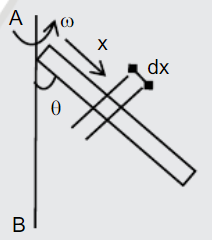A uniform metal rod of length 1 and mass m is rotating with an angular velocity of magnitude o about an axis passing through its centre and perpendicular to the rod. If the temperature of the rod increases by T∘C , then change in its magnitude of angular velocity varies directly with
1ω
√ω
ω
ω2
The correct Answer is:C
When the temperature of the rod increases by T∘C , length of the rod becomes
l.=l(1+αT)
where a is the coefficient of linear expansion. From the law of conservation of angular momentum, we have
Iω=I.ω.
⇒112ml2ω=112ml2ω.
⇒ω.ω=(ll.)2=1(1+αT)2=(1+αT)−2
For given value ofT,(1+αT)−2 is constant, say, C
∴ω.ω=C
ω.−ωω=C−1
⇒ω.−ω=(C−1)ω
⇒ω.−ω∝ω
Similar Questions
Knowledge Check
A rod of length 2 m has a mass of 0.24 kg. Its moment of inerita about an axis passing through its centre and perpendicular to the length of the rod is
A0.04 kg - m2B0.08 kg - m2C0.12 kg - m2D0.02 kg - m2A rod is rotating with angular velocity ω about axis AB. Find cosθ.
 Ag2lω2Bglω2C2g(lω)2D3g2lω2
Ag2lω2Bglω2C2g(lω)2D3g2lω2A uniform metal rod of length L and mass M is rotating about an axis passing throuth one of the ends perpendicular to the rod with angular speed ω. If the temperature increases by t∘C then the change in its angular velocity is proportional to which of the following ? (Coefficient of linear expansion of rod =α)
A√ωBωCω2D1/ω
The radius of gyration of a uniform rod of length l about an axis passing through one of its ends and perpendicular to its length is
View SolutionA metallic rod of length I rotates at angular velocity ω about an axis passing through one end and perpendicular to the rod. If mass of electron is m and its charge is -e then the magnitude of potential difference between its two ends is
View SolutionThe radius of gyration of a uniform rod of length L about an axis passing through its centre of mass is
View SolutionThe radius of gyration of a uniform rod of length L about an axis passing through its centre of mass is
View SolutionA uniform rod of mass m and length l rotates in a horizontal plane with an angular velocity ω about a vertical axis passing through one end. The tension in the rod at a distance x from the axis is
View Solution

